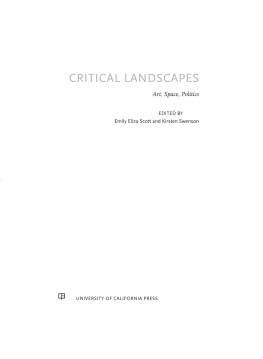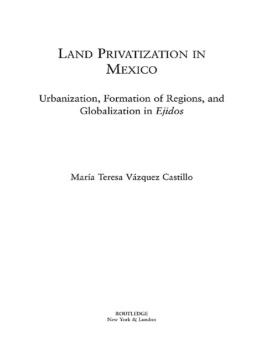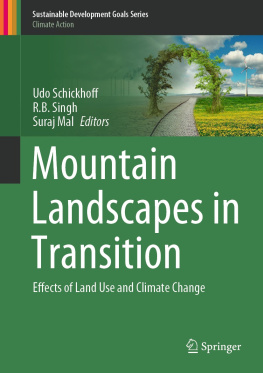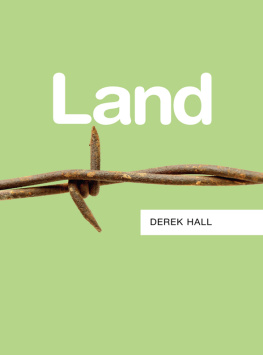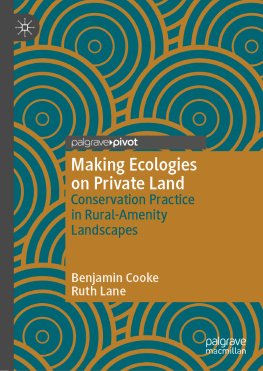University of California Press, one of the most distinguished university presses in the United States, enriches lives around the world by advancing scholarship in the humanities, social sciences, and natural sciences. Its activities are supported by the UC Press Foundation and by philanthropic contributions from individuals and institutions. For more information, visit www.ucpress.edu.
Critical landscapes : art, space, politics / edited by Emily Eliza Scott and Kirsten Swenson.
Includes bibliographical references.
ISBN 978-0-520-28548-4 (cloth : alk. paper)
ISBN 978-0-520-28549-1 (pbk. : alk. paper)
1. Landscapes in art. 2. Landscape architecture. 3. ArtPolitical aspects. 4. Land usePolitical aspects. 5. Cultural landscapes. I. Scott, Emily Eliza, 1971 editor. II. Swenson, Kirsten, editor.
N 8213. C 75 2015
The paper used in this publication meets the minimum requirements of ANSI/NISO Z 39.481992 ( R 1997) ( Permanence of Paper ).
CONTENTS
Emily Eliza Scott and Kirsten Swenson
After the Production of Space
Experimental Geography: From Cultural Production to the Production of Space
Critical Day Trips: Tourism and Land-Based Practice
Sahara Chronicle (20069)
on Francis Als, When Faith Moves Mountains (2002)
A Peoples Archive of Sinking and Melting (2012)
on The Otolith Group, The Radiant (2012)
Mirror Travel in the Motor City (2005)
Aftermath: Two Queer Artists Respond to Nuclear Spaces
Look Again: Subjectivity, Sovereignty, and Andrea Geyers Spiral Lands
Earthkeeping, Earthshaking
on Sigalit Landau, DeadSee (2005)
What Is a Photograph? (2013)
on Allora & Calzadilla, Land Mark (Foot Prints) (20012)
Where Eagles Dare (2013)
The Vanishing Indian Repeat Photography Project (2011)
on The Decolonizing Architecture Art Residency, Return to Jaffa (2012)
The Border Crossed Us (2011)
Another World, and Another... : Notes on Uneven Geographies
Documenting Accumulation by Dispossession
on Teddy Cruz, The Political Equator (200511)
on Santiago Sierra, Sumisin (Submission, formerly Word of Fire) (20067)
on Simon Starling, One Ton II (2005)
on George Osodi, Oil Rich Niger Delta (20037)
Deep Weather (2013)
on Tue Greenfort, Exceeding 2 Degrees (2007)
Area of Detail (2010)
The Land and the Economics of Sustainability
Growing Ecologies of Contemporary Art: Vignettes from Shanghai
on FlyingCity, All-things Park (2004)
on Nils Norman, The Contemporary Picturesque (2001)
on Laura Kurgan and Eric Cadora, Million Dollar Blocks (2005)
on The Center for Urban Pedagogy, Affordable Housing Toolkit (2010)
on Olga Koumoundouros, Notorious Possession (2012)
on eteam, International Airport Montello (20058)
on Vivan Sundaram, Trash (20058)
ILLUSTRATIONS
INTRODUCTION
Contemporary Art and the Politics of Land Use
Emily Eliza Scott and Kirsten Swenson
We cut the word in half, as if it was a sculpture, separated, divided it. The word mark now becomes a verb, something that marks the land, and in that marking the term means how the land is used, how a land differentiates itself from another land by the way it is being and has been markedland marked by colonization, land marked by war, by millions of reasons. These marking processes are what constitutes and defines the changing status of a land.
GUILLERMO CALZADILLA, ON LAND MARK (20015) BY ALLORA & CALZADILLA
A groundswell of art since the turn of the millennium has engaged the politics of land use, addressing topics from the widespread privatization of public spaces and resources to anthropogenic climate change, borderland conflicts, the Occupy movement, and the rhetoric of sustainable development. Some of the most compelling artists today are forging new representational and performative practices to reveal the social significance of hidden, or normalized, features inscribed in the land. Their work pivots around a set of evolving questions: In what ways is land, formed over the course of geological time, also contemporary, or formed by the conditions of the present? How do environmental and economic structures correlate? Can art spur more nuanced ways of thinking about and interacting with the land? How might art contribute to the expansion of spatial and environmental justice?
Certain artists negotiate the legacy of 1960s and 1970s Land art or the conditions of the global art world, while others actively eschew art-world reference points, choosing instead to position their work relative to disciplines such as cultural geography or urban planning, community-based activism, or even official land management agencies. This critical mass of land-focused practices, keyed to the geopolitics of the past two decades, constitutes a significant strand of contemporary art that has occasioned a likewise important body of scholarship, itself often borrowing ideas and methods from diverse fields.
The artists and writers included in Critical Landscapes take land to be neither pre-givenfixed, neutral, or natural nor as something to which we have unmediated access. Rather, they approach it as an outcome and an index of complex procedures. Here, the writings of the French Marxist philosopher Henri Lefebvre are a key influence. In his landmark book The Production of Space (originally published in 1974 and translated into English in 1991), Lefebvre traces the transformation of space under capitalism and, in so doing, theorizes space itself as a product of social relations and processes. More recently, and extending from Lefebvre, the art historian Rosalyn Deutsche has argued that space is political, inseparable from the conflictual and uneven social relations that structure specific societies at specific historical moments. The art surveyed in the following pages centers on questions of power and the role of visual representation (or a lack thereof) in struggles over land and its potential meanings and uses. In many cases, as Julian Myers-Szupinska observes in the opening essay, artists seek to reveal the production of space in order to detonate it, or to open ways for it to be produced otherwise.
This volume is organized into four sections: Against the Abstraction of Space, Land Claims: Space and Subjectivity, Geographies of Global Capitalism, and Urbanization With No Outside. These groupings are intended as loose aggregates, rather than clear delineations, with many overlapping ideas and issues. Each section includes full-length essays as well as brief entries on individual artworks, some of which are written by the artists themselves and others by scholars from a range of disciplines. While the theoretical framework, history, and artistic precedents touched upon in the following introduction reflect the primarily North American vantage point of the editors, Critical Landscapes incorporates work happening around the globe. Many artists do not share common reference points, having instead developed practices in response to local or regional contexts.

